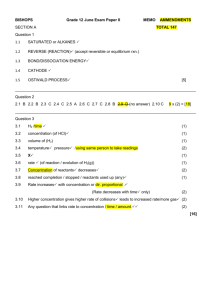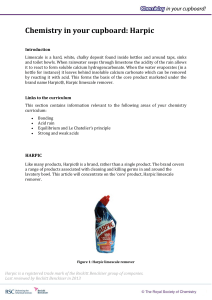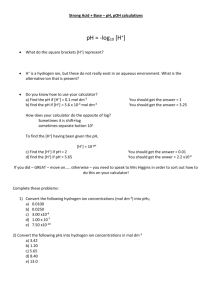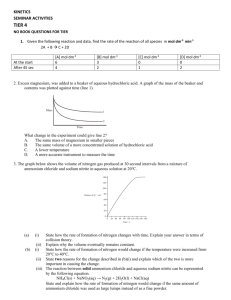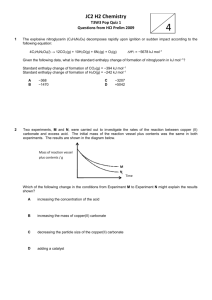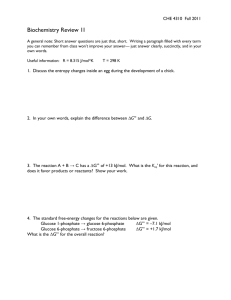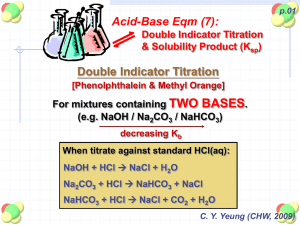Harpic - Royal Society of Chemistry
advertisement
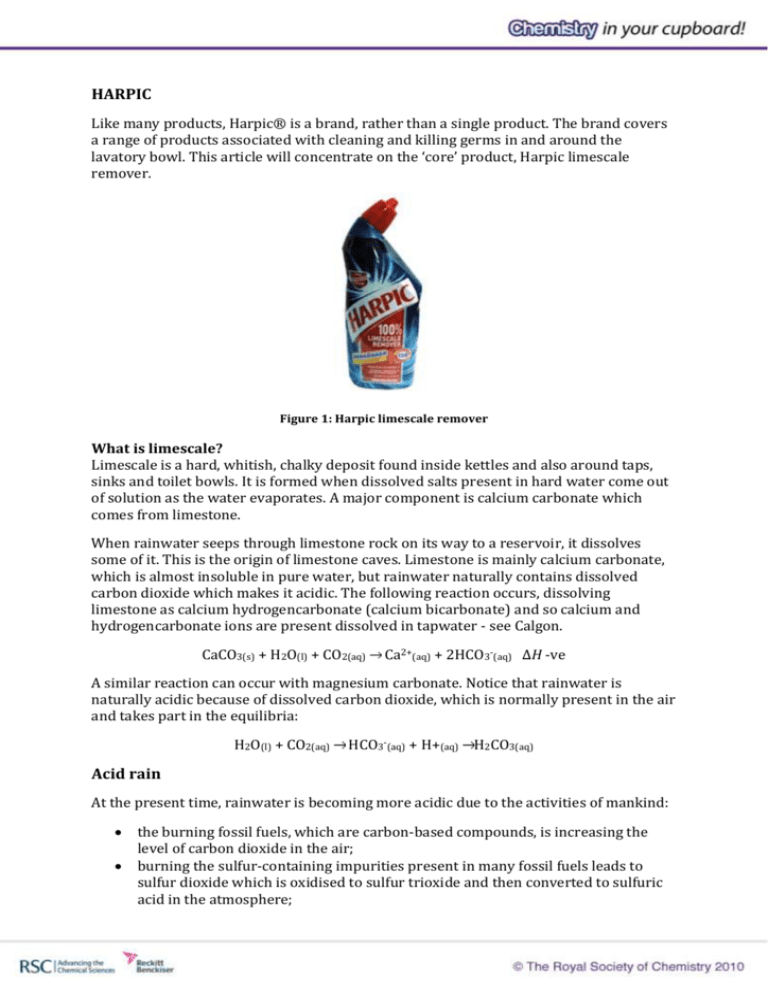
HARPIC Like many products, Harpic® is a brand, rather than a single product. The brand covers a range of products associated with cleaning and killing germs in and around the lavatory bowl. This article will concentrate on the ‘core’ product, Harpic limescale remover. Figure 1: Harpic limescale remover What is limescale? Limescale is a hard, whitish, chalky deposit found inside kettles and also around taps, sinks and toilet bowls. It is formed when dissolved salts present in hard water come out of solution as the water evaporates. A major component is calcium carbonate which comes from limestone. When rainwater seeps through limestone rock on its way to a reservoir, it dissolves some of it. This is the origin of limestone caves. Limestone is mainly calcium carbonate, which is almost insoluble in pure water, but rainwater naturally contains dissolved carbon dioxide which makes it acidic. The following reaction occurs, dissolving limestone as calcium hydrogencarbonate (calcium bicarbonate) and so calcium and hydrogencarbonate ions are present dissolved in tapwater - see Calgon. CaCO3(s) + H2O(l) + CO2(aq) Ca2+(aq) + 2HCO3-(aq) ΔH -ve A similar reaction can occur with magnesium carbonate. Notice that rainwater is naturally acidic because of dissolved carbon dioxide, which is normally present in the air and takes part in the equilibria: H2O(l) + CO2(aq) HCO3-(aq) + H+(aq) H2CO3(aq) Acid rain At the present time, rainwater is becoming more acidic due to the activities of mankind: the burning fossil fuels, which are carbon-based compounds, is increasing the level of carbon dioxide in the air; burning the sulfur-containing impurities present in many fossil fuels leads to sulfur dioxide which is oxidised to sulfur trioxide and then converted to sulfuric acid in the atmosphere; high temperature combustion processes combine oxygen and nitrogen from the air to form nitrogen oxides which then react with water to form nitric acid. Figure 2: Effect of acid rain on trees Question 1 Write balanced equations to show how a) sulfur burns in oxygen to form sulfur dioxide b) reacts with further oxygen to form sulfur trioxide c) how sulfur trioxide reacts with water in the atmosphere to form sulfuric acid As the water evaporates, the equilibrium CaCO3(s) + H2O(l) + CO2(aq) Ca2+(aq) + 2HCO3-(aq) ∆H –ve moves to the left to deposit calcium carbonate - limescale. Question 2 Suggest two reasons why limescale tends to form more around the hot tap than the cold tap in a bathroom sink. Dissolving limescale (1 of 2) Calcium carbonate is virtually insoluble in water but ‘dissolves’ readily in acids. Strictly it is reacting with them rather than simply dissolving. Harpic contains hydrochloric acid which dissolves limescale, calcium carbonate (CaCO3), as shown. CaCO3(s) + 2HCl(aq) CaCl2(aq) + CO2(g) + H2O(l) Hydrochloric acid is a strong acid which means that it dissociates completely into ions: HCl(aq) H+(aq) + Cl-(aq) Question 3 Hydrochloric acid is a solution of hydrogen chloride gas. a) Work out the volume (at room conditions) of hydrogen chloride dissolved in 1 dm3 Harpic. b) Work out the mass of hydrogen chloride dissolved in 1 dm3 Harpic. The concentration of HCl in Harpic is around 10%, which equates to approximately 3 mol dm-3. Question 4 Calculate [HCl] to produce a pH of 0 Other acids that are sometimes used in products for removing limescale are the weak acids sulfamic acid (SO3HNH2), formic acid (HCOOH) and phosphoric acid (H3PO4), Figure 3. Weak acids dissociate only partly in solution. sulfamic acid formic acid phosphoric acid Figure 3: Structures of sulfamic, formic and phosphoric acids Question 5 What is the systematic name of formic acid? The strength of a weak acid is measured by its pKa value : Sulfamic acid (HOSO2NH2) pKa = 0.99 Formic acid (HCOOH) pKa = 3.8 Phosphoric acid (H3PO4) pKa1 = 2.1; pKa2 = 7.20 ; pKa3 = 12.38 pKa value is a measure of how easily a H+ ion is lost. The larger the pKa value, the weaker the acid. Dissolving limescale (2 of 2) Imagine a weak acid HA which dissociates HA(aq) H+(aq) + A-(aq) The equilibrium constant is given by: Kc = [H (aq) ] eqm [A (aq) ] eqm [HA (aq) ] eqm For a weak acid, this is usually given the symbol Ka and called the acid dissociation constant. Ka = [H (aq) ] eqm [A (aq) ] eqm [HA (aq) ] eqm The pKa is defined as follows and is analogous with pH =-log10[H+]: pKa = – log10Ka Question 6 Calculate the pH of a 1 mol dm-3 solution of sulfamic acid. The larger the value of Ka, the stronger the acid i.e. the greater [H+] it produces on dissociation. However, because of the negative sign in the expression above, the larger the value of pKa, the weaker the acid. Question 7 a) Explain why, when formic acid dissociates, the hydrogen atom bonded to an oxygen is the one lost as a H+ ion rather than the one bonded to the carbon atom. b)The pKa of formic acid is 3.8, what is the value of Ka? Give the correct units c) Write an expression for Ka of formic acid (represent the acid as HCOOH) d) Calculate the pH of a 1 mol dm-3 solution of formic acid. e) Compare your answer for the pH of formic acid with that of 1 mol dm-3 hydrochloric acid (HCl), a strong acid. How much limescale will Harpic dissolve? CaCO3(s) + 2HCl(aq) CaCl2(aq) + H2O(l) + CO2(g) 1 mol 2 mol Consider a typical ‘dose’ of Harpic is approximately 50 cm3. Moles HCl = C xV 1000 = 1 x 50 1000 = 0.05 mol This will dissolve half this i.e 0.025 mol CaCO3 Mr CaCO3 = 100 g mol-1 So the Harpic will dissolve 2.5 g calcium carbonate. Mixing acid-based and bleach-based cleaners A number of other household cleaners such as Cillit Bang Toilet Cleaner are formulated with a chlorine-based bleach. These are essentially solutions of chlorine in alkali in which the following equilibrium is set up. Cl2(g) + OH-(aq) HClO(aq) + Cl-(aq) The active bleaching agent is HClO(aq), chloric(I) acid. It is important not to mix chlorine-based and acid-based cleaners (of any brand) and there are warnings to this effect on the bottles. On adding acid to bleach, the added acid will react with the OH- ions to form water and, by Le Chatelier’s principle, the equilibrium above will move to the left, with the consequent formation of poisonous chlorine gas. Not a good idea! In other words, the reaction HClO(aq) + HCl(aq) Cl2(g) + H2O(l) goes essentially to completion. Question 8 A similar product to Harpic states on the pack ‘this unique formula shows you where it is working by turning from green to blue and fizzing on contact with limescale’. Explain the fizzing and sggest how the colour change may be brought about. Question 9 Calculate how much chlorine could be produced from a typical dose of Harpic of 50 cm3 assuming that there was excess bleach. A reference database on chemical hazards, CLEAPSS Hazcards, gives the following information about chlorine: ‘Toxic by inhalation. Irritating to eyes, respiratory system and skin. WEL 1.5 mg m-3 (STEL)’ Let us put this in context. WEL stands for Workplace Exposure Limit and is the maximum concentration to which workers may be exposed by breathing, and STEL stands for Short Term Exposure Limit, i.e. an exposure for 15 minutes. Imagine a smallish bathroom 2 m x 2 m x 3 m. This gives a volume of 12 m3. This gives an average chlorine concentration of 3550 / 12 = 296 mg m-3. This is well above the quoted level of 1.5 mg m-3 for a 15 minute exposure. So this poses a significant problem. Let us check our assumptions and conditions Many bathrooms will be larger than the example given, thus reducing the concentration of chlorine Bathrooms are normally well-ventilated (often with a fan), so the chlorine would dissipate. Most people will not spend as long as 15 minutes in the room after cleaning the toilet. The smell of chlorine will alert people to the danger. Chlorine is denser than air and so will tend to remain in the toilet bowl rather than spreading throughout the room. Chlorine is fairly soluble so some of it would remain dissolved in the water in the toilet. However, this is clearly not a good idea, and care should be taken not to mix bleach and acid-based cleaners. In particular, people with breathing problems such as asthma might be more severely affected. Other ingredients (1 of 2) Harpic is not just a solution of hydrochloric acid. The ingredients of Harpic 100% limescale remover original are listed in Figure 3 in decreasing order of quantity. Figure 3: Ingredients of Harpic 100% limescale remover original ‘Aqua’ means water. Parfum and colour do as their name suggests and make the product pleasant to use. Of the other ingredients, PEG-2 hydrogenated tallow ammonium chloride, tallowtrimonium chloride and laureth-10 are detergents or surfactants. These are ‘tadpole-shaped’ molecules, that is they have a polar or ionic ‘head’ which will mix readily with water and a non-polar ‘tail’ There is strong hydrogen bonding between water molecules which forms a ‘skin’ (known as surface tension) at the surface of water and tends to pull it into droplets, Figure 4. Surfactant molecules, as the name implies, cluster at the water surface with heads in the water and tails sticking out and disrupt the hydrogen bonding. This allows water to spread and wet the surface. Figure 4: The surface tension of water causes it to form droplets on clean surfaces You can see this if you pour a little tap water onto a very clean porcelain surface such as a plate - it will tend to form droplets. Add a little washing up liquid (which contains surfactants) and the water will spread to cover the whole plate. The function of surfactants is to reduce the surface tension of water and allow the aqueous solution on which HARPIC is based to wet the porcelain surface of the toilet bowl effectively. This allows product to spread over the surface rather than form droplets. Other ingredients (2 of 2) PEG-2 hydrogenated tallow ammonium chloride and tallowtrimonium chloride are cationic detergents. They are based on quaternary ammonium compounds and have structures like the one in Figure 5. Cl+ H3N Figure 5: A quaternary ammonium compound surfactant The ionic head mixes with water while the hydrocarbon tail is non-polar. Cationic surfactants can be used in acid solution. Anionic surfactants such as soaps like the one in Figure 6 cannot be used in acid solutions because the hydrogen ions in the solution would react with the negative ions and protonate them. This produces a non-ionic and therefore insoluble compound O- O Na+ Figure 6: An anionic surfactant Question 10 a) Identify the functional group of the anionic surfactant in Figure 6. b) Write an equation to show the protonation of this group. Laureth-10, Figure 7, is a non-ionic surfactant based on the group –(CH2CH2O)n-. It is relatively polar with a non-polar hydrocarbon tail. OH O n Figure 7: A polyethylene ethoxylate – a non-ionic detergent Non-ionic surfactants can also be used in acid solutions. A further function of the tallow ammonium chloride is that it acts as a thickening agent so that the product will cling to the sides of the toilet pan and remain effective through many flushes. Harpic also contains a blue colouring agent so that the user can see clearly where the product is and can make sure that the whole of the toilet rim is covered, a task that would be more difficult with a colourless liquid. The acid in Harpic means that it is an effective germicide, killing ‘99.9% of germs’. Further information Harpic is sold in the UK by Reckitt Benckiser (www.reckittbenckiser.com/site/RKBR/Templates/OurBrandsSurfaceCare.aspx?pageid =253). There are other branded products which work in a similar way. Acknowledgements The Royal Society of Chemistry wishes to thank Chris Jones and David Kennedy of Reckitt Benckiser for help in preparing this material. QUESTIONS AND ANSWERS Question 1 Write balanced equations to show how a) sulfur burns in oxygen to form sulfur dioxide S(s) + O2(g) SO2(g) b) reacts with further oxygen to form sulfur trioxide SO2(g) + ½ O2(g) SO3(g) c) how sulfur trioxide reacts with water in the atmosphere to form sulfuric acid SO3(g) + H2O(l) H2SO4(aq) Question 2 Suggest two reasons why limescale tends to form more around the hot tap than the cold tap in a bathroom sink. The water evaporates due to the heat of the hot tap. The equilibrium moves to the left (by Le Chatelier’s principle) ie the direction in which it absorbs heat. Question 3 Hydrochloric acid is a solution of hydrogen chloride gas. a) Work out the volume (at standard temperature and pressure) of hydrogen chloride dissolved in 1 dm3 of Harpic. The volume of 1 mole of any gas at room temperature is approximately 24 000 cm3. So the volume of dissolved gas in a solution of 3 mol dm-3 HCl is approximately 72 000 cm3. b) Work out the mass of hydrogen chloride dissolved in 1 dm3 Harpic. Mr of HCl is 1 + 35.5 = 36.5 g mol-1 so the mass of 3 mol HCl = 109.5 g. Question 4 Calculate [HCl] to produce a pH of 0 pH = -log10[H+] 0 = -log10[H+] [H+] = inv log100 [H+] = 1 mol dm-3 Compare this to the concentration of HCl in Harpic which is 3 times higher. Interestingly Harpic has a pH of -0.48. Question 5 What is the systematic name of formic acid? Methanoic acid. Question 6 Calculate the pH of a 1 mol dm-3 solution of sulfamic acid. The pKa of sulfamic acid is 0.99 pKa = –log10 Ka so Ka = 10- 0.99 Ka = 0.10 mol dm-3 HOSO2NH2 ⇌ OSO2NH2- + H+ Ka = [OSO 2NH 2 - (aq) ] eqm [H (aq) ] eqm [HOSO 2NH 2 (aq) ] eqm [OSO2NH2-(aq)]eqm = [H+(aq)]eqm [HOSO2NH2(aq)]eqm= 1 - [H+(aq)]eqm ≈ 1 (We can safely make this assumption for a weak acid) So 0.10 = [H (aq) ] 2 eqm 1 [H+(aq)]eqm = √0.10 = 0.316 mol dm-3 pH = –log10 [H+(aq)]eqm = 0.5 Question 7 a) Explain why, when formic acid dissociates, the hydrogen atom bonded to an oxygen is the one lost as a H+ ion rather than the one bonded to the carbon atom. Oxygen is significantly more electronegative than hydrogen (3.5 as opposed to 2.1). So the O-H bond is polarised Oδ- - Hδ+ making loss of the hydrogen as H+ easy. Carbon’s electronegativity is similar to that of hydrogen (2.5 to 2.1) so the C-H bond is relatively non-polar and there is little tendency for the H atom to acquire a positive charge. b)The pKa of formic acid is 3.8, what is the value of Ka? Give the correct units pKa = –log10 Ka so Ka = 1.6 x 10-3 mol dm-3 c) Write an expression for Ka of formic acid (represent the acid as HCOOH) Ka = [HCOO - (aq) ] eqm [H (aq) ] eqm [HCOOH (aq) ] eqm d) Calculate the pH of a 1 mol dm-3 solution of formic acid. [HCOO- (aq)]eqm = [H+(aq)]eqm [HCOOH(aq)]eqm= 1 - [H+(aq)]eqm ≈ 1 (We can safely make this assumption for a weak acid) So 1.6 x 10-3 = [H (aq) ] 2 eqm 1 [H+(aq)]eqm = √1.6 x 10-3 = 0.04 mol dm-3 pH = –log10 [H+(aq)]eqm = 1.4 e) Compare your answer for the pH of formic acid with that of 1 mol dm-3 hydrochloric acid (HCl), a strong acid. Hydrochloric acid dissociates completely in solution HCl(aq) H+(aq) + Cl-(aq) So [H+]eqm = 1 mol dm-3 pH = –log10 [H+(aq)]eqm = 0 Question 8 A similar product to Harpic states on the pack ‘this unique formula shows you where it is working by turning from green to blue and fizzing on contact with limescale’. Explain the fizzing and sggest how the colour change may be brought about. The fizzing is carbon dioxide produced by the reaction of hydrochloric acid and calcium carbonate in the limescale. The colour change could be brought about by adding a suitable acid base indicator that changes colour as the acid is used up. Question 9 Calculate how much chlorine could be produced from a typical dose of Harpic of 50 cm3 assuming that there was excess bleach. HClO(aq) + HCl(aq) Cl2(g) + H2O(l) Assume the equilibrium is forced completely to the right. 1 mol HCl will produce 1 mol chlorine In a 50 cm3 dose of Harpic of concentration 1 mol dm-3 Moles HCl = C xV 1000 = 1 x 50 1000 = 5 x 10-2 mol So 5 x 10-2 mol Cl2 will be produced At room temperature 1 mole of any gas has an approximate volume of 24 dm3 (24 000 cm3) So volume Cl2 = 24 000 x 5 x 10-2 cm3 = 1200 cm3 Mr Cl2 = 71, so this is equivalent to a mass of chlorine of 71 x 5 x 10-2 g = 3.55 g or 3550 mg. Question 10 a) Identify the functional group of the anionic surfactant in Figure 6. Carboxylic acid (the sodium salt of a carboxylic acid) COO-. b) Write an equation to show the protonation of this group. RCOO- + H+ → RCOOH
